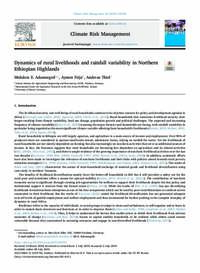Dynamics of rural livelihoods and rainfall variability in Northern Ethiopian Highlands

Authors:
The study has aimed to reveal the livelihood dynamics of rural households in Ethiopia and their association with rainfall conditions and household socio-economic characteristics. It has observed an upward livelihood patterns but fluctuating over the study period. The econometric estimations have shown that rainfall conditions during the main rainy season in Ethiopia significantly and negatively affect household decisions to engage in non-farm livelihoods, specifically wage employment. This result has two implications: First, wage employment in rural Ethiopia is mainly casual and generally offers a low return. Second, household decisions to engage in non-farm livelihoods are primarily driven by expected low returns from farming, due to adverse climatic conditions (mainly rainfall). The analysis has also indicated that household socio-economic characteristics strongly influence decisions about pursuing nonfarm livelihoods. Household demographic characteristics such as adult household members appear to positively and significantly determine their decisions regarding whether to engage in wage employment or not. Whereas, access to financial resources from credit institutes, remittances or Iqub have been found to play a role in positively and significantly determining their decisions about undertaking business activities. The study has observed high and significant variation between the study communities with regard to the proportion of households engaged in non-farm livelihoods. These differences are primarily driven by structural differences in terms of access to all-weather roads, markets or developmental activities being available in the community. The study has demonstrated that the main reason for household decisions to pursue non-farm livelihoods is adverse rainfall conditions during the main growing season, which consequently affect farming. It has also observed the potential that non-farm livelihoods offer to rural households: either as the main source of income or as a substantial supplement during adverse rainfall conditions. D’haen et al. (2014) suggest, however, that non-farm livelihoods should not be viewed as a buffer during adverse climate conditions but rather as a core strategy for rural development. However, our study restrains itself from such claims until deep societal and economic change is observed, as such significant changes need policy and strategic interventions towards non-farm livelihood in rural communities. For policy-making, it is important to understand how designing policy and strategic interventions contribute towards the enhancement of non-farm livelihoods and the ways in which they can, in turn, make significant contributions to rural development. Their contribution could be either as a supplement to farming through enabling rural households’ to invest in farming or as a core livelihood activity by themselves. The findings of this study have a variety of policy implications. First, increasing the access of households to financial schemes through local credit institutes or local groups, such as Iqub, may enable them not only to take part in non-farm livelihood activities but also to be able to readily choose the profitable ones which offer the highest returns. This may, in turn, improve household capacities to invest in agriculture and, subsequently, improve overall income (Bezu et al., 2012). Second, there is a need to increase household-member skills through vocational training and education to increase competitiveness, which would enable rural households to more successfully pursue business activities and increase their chances of getting well paid wage M.E. Adamseged, et al. Climate Risk Management 25 (2019) 100195 12 work. Third, increasing household access to markets, through developing appropriate institutions, communication technologies, and infrastructure, would likely generate important livelihood opportunities.
